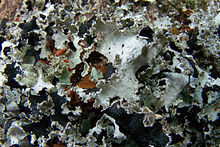Platismatia
| Platismatia | |
|---|---|
 |
|
| Platismatia glauca growing on a Nothofagus tree on Isla Navarino, Chile. | |
| Scientific classification | |
| Kingdom: | Fungi |
| Division: | Ascomycota |
| Class: | Lecanoromycetes |
| Suborder: | Lecanorineae |
| Family: | Parmeliaceae |
| Genus: |
Platismatia W.L.Culb. & C.F.Culb. (1968) |
| Type species | |
|
Platismatia glauca (L.) W.L.Culb. & C.F.Culb. (1968) |
|
| Species | |
|
P. commixtum |
|
P. commixtum
P. erosa
P. formosana
P. glauca
P. herrei
P. interrupta
P. lacunosa
P. norvegica
P. regenerans
P. stenophylla
P. tuckermanii
P. wheeleri
Platismatia is genus of medium to large foliose lichens with rather crinkled lobes. The genus is widespread and contains 10 species. They resemble many other genera of foliose lichens in the family Parmeliaceae, particularly Parmotrema, Cetrelia, and Asahinea. Most species are found in forests on the trunks and branches of conifer trees, although some species grow on rocks.
Species of Platismatia can be used to produce an orange-brown, yellow-brown, or brown dye, and at least one species was traditionally used to dye wool in Europe.
Platismatia glauca, Schwäbisch-Fränkische Waldberge, Germany
Platismatia glauca, Schwäbisch-Fränkische Waldberge, Germany
Platismatia wheeleri, Underside of thallus; Yelm, Washington, United States
...
Wikipedia
